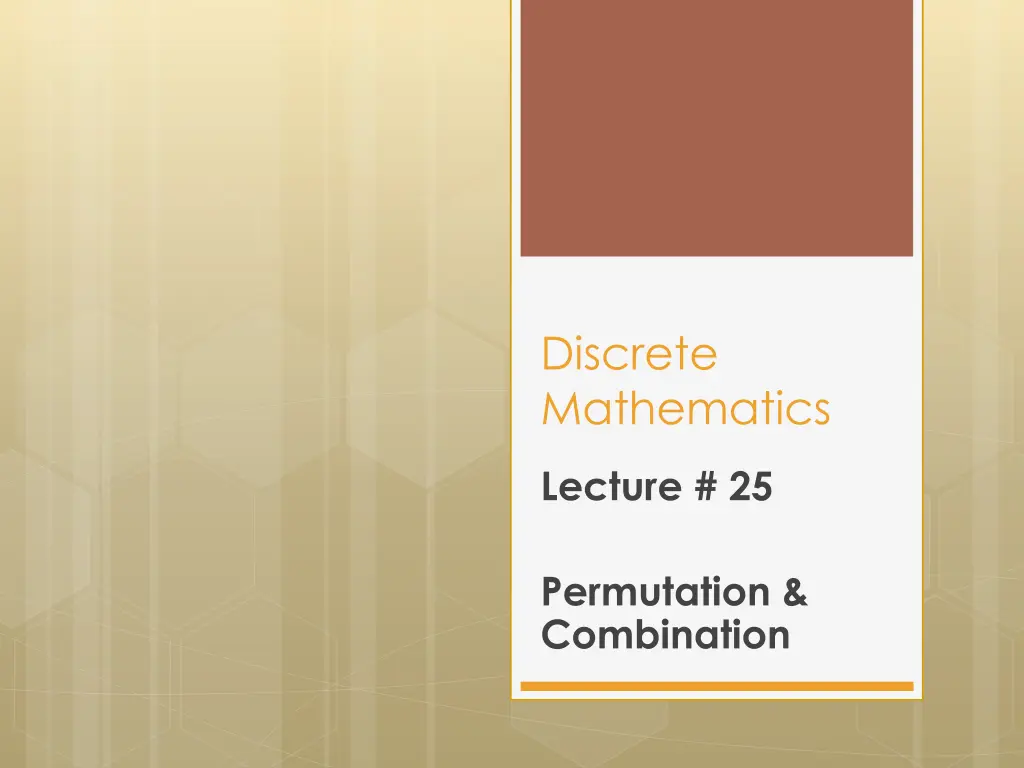
Discrete Mathematics: Permutation and Combination Concepts
Explore the concepts of permutation and combination in discrete mathematics, including k-permutations, formulas, exercises, and solutions. Understand how to calculate permutations, solve problems, and determine possible outcomes within sets of elements.
Download Presentation

Please find below an Image/Link to download the presentation.
The content on the website is provided AS IS for your information and personal use only. It may not be sold, licensed, or shared on other websites without obtaining consent from the author. If you encounter any issues during the download, it is possible that the publisher has removed the file from their server.
You are allowed to download the files provided on this website for personal or commercial use, subject to the condition that they are used lawfully. All files are the property of their respective owners.
The content on the website is provided AS IS for your information and personal use only. It may not be sold, licensed, or shared on other websites without obtaining consent from the author.
E N D
Presentation Transcript
Discrete Mathematics Lecture # 25 Permutation & Combination
k-PERMUTATION A k-permutation of a set of n elements is a selection of k elements taken from the set of n elements such that the order of elements matters but repetition of the elements is not allowed. The number of k-permutations of a set of n elements is denoted P(n, k) or
REMARK 1. With k-permutation, repetition of elements is not allowed, therefore k n. 2. The wording number of permutations of a set with n elements means that all n elements are to be permuted, so that k = n.
FORMULA FOR k-PERMUTATION Suppose a set of n elements is given. Formation of a k-permutation means that we have an ordered selection of k elements out of n, where elements cannot be repeated. 1st element can be selected in n ways 2nd element can be selected in (n-1) ways 3rd element can be selected in (n-2) ways . kth element can be selected in (n-(k-1)) ways
FORMULA FOR k-PERMUTATION Hence, by product rule, the number of ways to form a k-permutation is
Exercise How many 2-permutation are there of {W, X, Y, Z}? Write them all. SOLUTION: Number of 2-permutation of 4 elements is These 12 permutations are: WX, WY, WZ, XW, XY, XZ, YW, YX, YZ, ZW, ZX, ZY. 4! 4 p = = (4,2) P (4 2)! 2 4 3 2! 2! 4 3 12 = = =
Exercise Find (a) P(8, 3) (c) P(8,1) Solution (b) P(8,8) (d) P(6,8) 8! = 8 7 6 = = ( ) a (8,3) 336 P (8 3)! 8! (8 8)! 8! (8 1)! 8! 0! 8 7! 7! = = = = 0! 1) = ( ) b (8,8) 8! 40320 ( P as = = = ( ) c (8,1) 8 P ( ) d (6,8) is not defined, since the second integer cannot exceed the first integer. P
Exercise Find n if (a)P(n,2) = 72 (b)P(n,4) = 42 P (n, 2) SOLUTION: (a) n (n-1) = 72 (by using the definition of permutation) n2-n = 72 n2- n - 72 = 0 n = 9, -8 Since n must be positive, so the only acceptable value of n is 9. Given P(n,2) = 72
Solution (b) the definition of permutation) (n-2) (n-3) = 42 n2- 5n + 6 = 42 or n2- 5n - 36 = 0 or (n-9) (n+4) = 0 n = 9, -4 Since n must be positive, the only answer is n = 9 Given P(n,4) = 42P(n,2) n (n-1) (n-2) (n-3) = 42 n (n - 1) (by using if n 0, n 1
Exercise Prove that for all integers n 3 P (n + 1, 3) - P(n, 3) = 3 P (n, 2) SOLUTION: Suppose n is an integer greater than or equal to 3 NowL.H.S = P (n + 1, 3) - P(n, 3) = (n + 1) (n) (n-1) - n (n - 1)(n - 2) = n (n - 1) [(n + 1) - (n - 2)] = n (n - 1) [n + 1 - n + 2] = 3 n (n - 1) R.H.S = 3P (n, 2) = 3 n(n-1) Thus L.H.S = R.H.S. Hence the result.
Exercise (a) How many ways can five of the letters of the word ALGORITHM be selected and written in a row? (b) How many ways can five of the letters of the word ALGORITHM be selected and written in a row if the first two letters must be TH?
Exercise Find the number of ways that a party of seven persons can arrange themselves in a row of seven chairs.
Exercise A debating team consists of three boys and two girls. Find the number n of ways they can sit in a row if the boys and girls are each to sit together. SOLUTION: There are two ways to distribute them according to sex: BBBGG or GGBBB. In each case the boys can sit in a row in P(3,3) = 3! = 6 ways, and the girls can sit in P(2,2) = 2! = 2 ways and Every row consist of boy and girl which is = 2!=2 Thus The total number of ways=n = 2 3! 2! = 2 6 2 = 24
Exercise Find the number n of ways that five large books, four medium sized book, and three small books can be placed on a shelf so that all books of the same size are together. SOLUTION: In each case, the large books can be arranged among themselves in P(5,5)= 5! ways, the medium sized books in P(4,4) = 4! ways, and the small books in P(3,3) = 3! ways. The three blocks of books can be arranged on the shelf in P(3,3) = 3! ways. Thus n = 3! 5! 4! 3! = 103680
K-COMBINATIONS With a k-combinations the order in which the elements are selected does not matter and the elements cannot repeat.
Definition A k-combination of a set of n elements is a choice of k elements taken from the set of n elements such that the order of the elements does not matter and elements can t be repeated. The symbol C(n, k) denotes the number of k- combinations that can be chosen from a set of n elements.
Remark With k-combinations of a set of n elements, repetition of elements is not allowed, therefore, k must be less than or equal to n, i.e., k n.
Example Let X = {a, b, c}. Then 2-combinations of the 3 elements of the set X are: {a, b}, {a, c}, and {b, c}. Hence C(3,2) = 3.
Exercise Let X = {a, b, c, d, e}. List all 3-combinations of the 5 elements of the set X, and hence find the value of C(5,3). SOLUTION: Then 3-combinations of the 5 elements of the set X are: {a, b, c}, {a, b, d}, {a, b, e}, {a, c, d}, {a, c, e}, {a, d, e}, {b, c, d}, {b, c, e}, {b, d, e}, {c, d, e} Hence C(5, 3) = 10
PERMUTATIONS AND COMBINATIONS Let X = {A, B, C, D}. The 3-combinations of X are: {A, B, C}, {A, B, D}, {A, C, D}, {B, C, D} Hence C(4, 3) = 4 The 3-permutations of X can be obtained from 3- combinations of X as follows. ABC, ACB, BAC, BCA, CAB, CBA ABD, ADB, BAD, BDA, DAB, DBA ACD, ADC, CAD, CDA, DAC, DCA BCD, BDC, CBD, CDB, DBC, DCB So that P(4, 3) = 24 = 4 6 = 4 3!
PERMUTATIONS AND COMBINATIONS Clearly P(4, 3) = C(4, 3) 3! In general we have, In general we have, or But we know that Hence, P(n, k) = C(n, k) k! P(n, k) = C(n, k) k! ( , ) ! k P n k = ( , ) C n k ! k ! )! ! k k n n = ( , ) P n k ( )! n = ( , ) C n k ( n
Example Compute C(9, 6). Solution:
SOME IMPORTANT RESULTS (a) C(n, 0) = 1 (b) C(n, n) = 1 (c) C(n, 1) = n (d) C(n, 2) = n(n-1)/2 (e) C(n, k) = C(n, n k) (f) C(n, k) + C(n, k + 1) = C(n + 1, k + 1)
EXERCISE A student is to answer eight out of ten questions on an exam. (a) Find the number m of ways that the student can choose the eight questions (b) Find the number m of ways that the student can choose the eight questions, if the first three questions are compulsory. SOLUTION: (a) The eight questions can be answered in C(10, 8) = 45 ways. (b) The eight questions can be answered in C(7, 5) = 21 ways. m = m =
Exercise An examination paper consists of 5 questions in section A and 5 questions in section B. A total of 8 questions must be answered. In how many ways can a student select the questions if he is to answer at least 4 questions from section A.
Solution There are two possibilities: (a) The student answers 4 questions from section A and 4 questions from section B. The number of ways 8 questions can be answered taking 4 questions from section A and 4 questions from section B are C(5, 4) C(5, 4) =5 5 = 25. (b) The student answers 5 questions from section A and 3 questions from section B. The number of ways 8 questions can be answered taking 5 questions from section A and 3 questions from section B are C(5, 5) C(5, 3) =1 10 = 10. Thus there will be a total of 25 + 10 = 35 choices.
Exercise A computer programming team has 14 members. (a) How many ways can a group of seven be chosen to work on a project? (b) Suppose eight team members are women and six are men (i) How many groups of seven can be chosen that contain four women and three men (ii) How many groups of seven can be chosen that contain at least one man? (iii)How many groups of seven can be chosen that contain at most three women? (c) Suppose two team members refuse to work together on projects. How many groups of seven can be chosen to work on a project? (d) Suppose two team members insist on either working together or not at all on projects. How many groups of seven can be chosen to work on a project? (a) How many ways a group of 7 be chosen to work on a project?
Solution (a)Number of committees of 7 14! = (14,7) C 7)! 7! (14 14 13 12 11 10 9 8 7 6 5 4 3 2 3432 = =
Solution (b) Suppose eight team members are women and six are men (i) How many groups of seven can be chosen that contain four women and three men? Number of groups of seven that contain four women and three men 4 3 2 3 2 70 20 1400 = = 8! 6! = (8,4) (6,3) C C (8 4)! 4! (6 3)! 3! 8 7 6 5 6 5 4 4! 8 7 6 5 6 5 4 = 3! =
Solution (b) Suppose eight team members are women and six are men (ii) How many groups of seven can be chosen that contain at least one man? Total number of groups of seven Number of groups of seven that contain no men Hence, the number of groups of seven that contain at least one man C(14,7) C(8, 7) = 3432 8 =3424 14! 7)! 7! = (14,7) C (14 14 13 12 11 10 9 8 7 6 5 4 3 2 3432 = = ! 8 = ) 7 , 8 ( C ! 7 8 ( = 7 )! 8
Solution (b)Suppose eight team members are women and six are men (iii) How many groups of seven can be chosen that contain at most three women? Number of groups of seven that contain no women = 0 Number of groups of seven that contain one woman = C(8,1) C(6,6) = 8 1 = 8 Number of groups of seven that contain two women = C(8,2) C(6,5) = 28 6 = 168 Number of groups of seven that contain three women = C(8,3) C(6,4) = 56 15 = 840 Hence the number of groups of seven that contain at most three women = 0 + 8 + 168 + 840 = 1016
Solution (c) Suppose two team members refuse to work together on projects. How many groups of seven can be chosen to work on a project? Call the members who refuse to work together A and B. Number of groups of seven that contain neither A nor B Number of groups of seven that contain A but not B C(12, 6) = 924 Number of groups of seven that contain B but not A C(12,6) = 924 Hence the required number of groups are C(12,7) + C(12,6) + C(12, 6) = 792 + 924 + 924 = 2640 12! 7)! 7! = (12,7) C (12 792 =
Solution (d)Suppose two team members insist on either working together or not at all on projects. How many groups of seven can be chosen to work on a project? Call the members who insist on working together C and D. Number of groups of seven containing neither C nor D C(12, 7) = 792 Number of groups of seven that contain both C and D C(12, 5) = 792 Hence the required number = C(12, 7) + C(12, 5) = 792 + 792 = 1584
Exercise (a) How many 16-bit strings contain exactly 9 1 s? (b)How many 16-bit strings contain at least one 1? SOLUTION: (a) 16-bit strings that contain exactly 9 1 s= (b) Total no. of 16-bit strings = 2 Hence number of 16-bit strings that contain at least one 1 2 = 65535 16! = = (16,9) 11440 C (16 9)!9! 16 16 1 = 65536 1
K-SELECTIONS k-selections are similar to k-combinations in that the order in which the elements are selected does not matter, but in this case repetitions can occur.
DEFINITION A k-selection of a set of n elements is a choice of k elements taken from a set of n elements such that the order of elements does not matter and elements can be repeated.
REMARK 1. k-selections are also called k-combinations with repetition allowed or multisets of size k. 2. With k-selections of a set of n elements repetition of elements is allowed. Therefore k need not to be less than or equal to n.
Theorem The number of k-selections that can be selected from a set of n elements is k+n -1 c k C(k+n 1, k) or
Exercise A camera shop stocks ten different types of batteries. (a) How many ways can a total inventory of 30 batteries be distributed among the ten different types? (b) Assuming that one of the types of batteries is A76, how many ways can a total inventory of 30 batteries be distributed among the 10 different types if the inventory must include at least four A76 batteries?
Solution (a) k = 30 n = 10 The required number is C(30 + 10 1, 30) (b) k = 26 n = 10 The required number is C(26 + 10 1, 26) = C(35, 26) = C(39, 30) 39! 30)!30! = (39 = 211915132 = 35! (35 26)!26! = 70607460
Table with Formulas ORDER MATTERS ORDER DOES NOT MATTER k-sample nk k-selection C(n+k-1, k) REPETITION ALLOWED k-permutation P(n, k) k-combination C(n, k) REPETITION NOT ALLOWED
ORDERED AND UNORDERED PARTITIONS An unordered partition of a finite set S is a collection [A1, A2, , Ak] of disjoint (nonempty) subsets of S (called cells) whose union is S. The partition is ordered if the order of the cells in the list counts.
Example Let S = {1, 2, 3, , 7} The collections P1= [{1,2}, {3,4,5}, {6,7}] And P2= [{6,7}, {3,4,5}, {1,2}] determine the same partition of S but are distinct ordered partitions.
Example Suppose a box B contains seven marbles numbered 1 through 7. Find the number m of ways of drawing from B firstly two marbles, then three marbles and lastly the remaining two marbles.
Solution The number of ways of drawing 2 marbles from 7 = C(7, 2) Following this, there are five marbles left in B. The number of ways of drawing 3 marbles from 5 = C(5, 3) Finally, there are two marbles left in B. The number of way of drawing 2 marbles from 2 = C(2, 2) Thus 2!3!2! 7 2 7! 2!5! 2!3! 2!0! 7! = 5 3 2 2 = m 5! 2! = = 210
Theorem Let S contain n elements and let n1, n2, , nk be positive integers with n1+n2+ +nk = n. Then there exist different ordered partitions of S of the form [A1, A2, , Ak], where A1 contains n1 elements A2 contains n2 elements A3 contains n3 elements .. Ak contains nk elements ! n ! ! ! ! n n n n 1 2 3 k
Remark To find the number of unordered partitions, we have to count the ordered partitions and then divide it by suitable number to erase the order in partitions.
Exercise Find the number m of ways that nine toys can be divided among four children if the youngest child is to receive three toys and each of the others two toys. Solution We find the number m of ordered partitions of the nine toys into four cells containing 3, 2, 2 and 2 toys respectively. Hence 2520 = 9! = m 3!2!2!2!



















